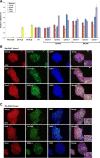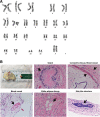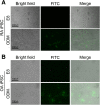Generation of disease-specific induced pluripotent stem cells from patients with rheumatoid arthritis and osteoarthritis
- PMID: 24490617
- PMCID: PMC3978583
- DOI: 10.1186/ar4470
Generation of disease-specific induced pluripotent stem cells from patients with rheumatoid arthritis and osteoarthritis
Abstract
Introduction: Since the concept of reprogramming mature somatic cells to generate induced pluripotent stem cells (iPSCs) was demonstrated in 2006, iPSCs have become a potential substitute for embryonic stem cells (ESCs) given their pluripotency and "stemness" characteristics, which resemble those of ESCs. We investigated to reprogram fibroblast-like synoviocytes (FLSs) from patients with rheumatoid arthritis (RA) and osteoarthritis (OA) to generate iPSCs using a 4-in-1 lentiviral vector system.
Methods: A 4-in-1 lentiviral vector containing Oct4, Sox2, Klf4, and c-Myc was transduced into RA and OA FLSs isolated from the synovia of two RA patients and two OA patients. Immunohistochemical staining and real-time PCR studies were performed to demonstrate the pluripotency of iPSCs. Chromosomal abnormalities were determined based on the karyotype. SCID-beige mice were injected with iPSCs and sacrificed to test for teratoma formation.
Results: After 14 days of transduction using the 4-in-1 lentiviral vector, RA FLSs and OA FLSs were transformed into spherical shapes that resembled embryonic stem cell colonies. Colonies were picked and cultivated on matrigel plates to produce iPSC lines. Real-time PCR of RA and OA iPSCs detected positive markers of pluripotency. Immunohistochemical staining tests with Nanog, Oct4, Sox2, Tra-1-80, Tra-1-60, and SSEA-4 were also positive. Teratomas that comprised three compartments of ectoderm, mesoderm, and endoderm were formed at the injection sites of iPSCs. Established iPSCs were shown to be compatible by karyotyping. Finally, we confirmed that the patient-derived iPSCs were able to differentiate into osteoblast, which was shown by an osteoimage mineralization assay.
Conclusion: FLSs derived from RA and OA could be cell resources for iPSC reprogramming. Disease- and patient-specific iPSCs have the potential to be applied in clinical settings as source materials for molecular diagnosis and regenerative therapy.
Figures




References
-
- Tiscornia G, Vivas EL, Izpisúa Belmonte JC. Diseases in a dish: modeling human genetic disorders using induced pluripotent cells. Nat Med. 2011;16:1570–1576. - PubMed
-
- Grskovic M, Javaherian A, Strulovici B, Daley GQ. Induced pluripotent stem cells – opportunities for disease modelling and drug discovery. Nat Rev Drug Discov. 2011;16:915–929. - PubMed
Publication types
MeSH terms
LinkOut - more resources
Full Text Sources
Other Literature Sources
Medical
Research Materials

